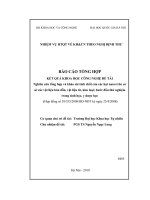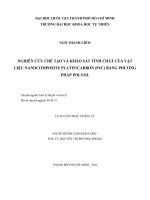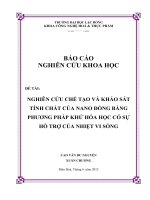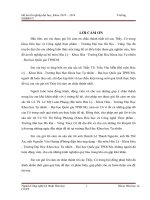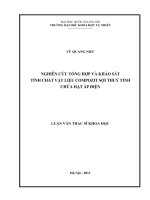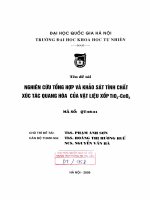Nghiên cứu tổng hợp và khảo sát tính chất của hệ vật liệu 2 chiều MoS2 rGO ứng dụng làm điện cực trong siêu tụ điện
Bạn đang xem bản rút gọn của tài liệu. Xem và tải ngay bản đầy đủ của tài liệu tại đây (1.97 MB, 75 trang )
NGO QUANG MINH
BỘ GIÁO DỤC VÀ ĐÀO TẠO
TRƯỜNG ĐẠI HỌC BÁCH KHOA HÀ NỘI
---------------------------------------
Ngo Quang Minh
SCIENCE AND
ENGINEERING OF
ELECTRONIC MATERIALS
SYNTHESIS AND PROPERTIES OF 2D MATERIALS
MOS2/GRAPHENE APPLIED FOR ELECTRODES IN
SUPERCAPACITOR
MASTER THESIS OF SCIENCE
MATERIALS SCIENCE
2016-2018
Ha Noi – 2018
MINISTRY OF EDUCATION AND TRAINING
HANOI UNIVERSITY OF SCIENCE AND TECHNOLOGY
--------------------------------------Ngo Quang Minh
SYNTHESIS AND PROPERTIES OF 2D MATERIALS
MOS2/GRAPHENE APPLIED FOR ELECTRODES IN
SUPERCAPACITOR
Major: Science and Engineering of Electronic Materials
MASTER THESIS OF SCIENCE
MATERIALS SCIENCE
SUPERVISOR:
Assoc. Prof., Dr. Nguyen Duc Hoa
Ha Noi – 2018
CỘNG HÒA XÃ HỘI CHỦ NGHĨA VIỆT NAM
Độc lập – Tự do – Hạnh phúc
BẢN XÁC NHẬN CHỈNH SỬA LUẬN VĂN THẠC SĨ
Họ và tên tác giả luận văn: Ngô Quang Minh
Đề tài luận văn: Nghiên cứu tổng hợp và khảo sát tính chất của vật
liệu 2 chiều MoS2/graphen ứng dụng làm điện cực trong siêu tụ điện
Chuyên ngành: Khoa học và kỹ thuật vật liệu điện tử
Mã số HV: CB160069
Tác giả, Người hướng dẫn khoa học và Hội đồng chấm luận văn
xác nhận tác giả đã sửa chữa, bổ sung luận văn theo biên bản họp Hội
đồng ngày 30/10/2018 với các nội dung sau:
Tiêu đề chương để chữ in hoa, giữa dòng.
Sắp xếp lại phần chữ và hình để thu hẹp các khoảng giấy trống
nhiều, dẫn tới số trang luận văn có sự thay đổi.
Tăng độ phân giải các hình ảnh bị mờ, 3.5; 3.6; 3.7; 3.8; 3.9; 3.10.
Đã chỉnh sửa lỗi về mô tả tiêu đề hình 3.11.
Ngày 5 tháng 11 năm 2018
Giáo viên hướng dẫn
CHỦ TỊCH HỘI ĐỒNG
Tác giả luận văn
STATEMENT OF ORIGINAL AUTHORSHIP
I hereby declare that the results presented in the thesis are performed by the author.
The research contained in this thesis has not been previously submitted to meet
requirements for an award at this or any higher education institutions.
Hanoi, 30/9/2018
Signature
LIST OF PUBLICATIONS
Ngo Quang Minh, Chu Manh Hung, Dang Thi Thanh Le, Nguyen Duc Hoa* and
Nguyen Van Hieu (2018), “Synthesis and characterization of MoS2/rGO
nanocomposite for supercapacitor applications”, The 9th International Workshop on
Advanced Materials Science and Nanotechnology (IWAMSN 2018), Ninh Binh,
Vietnam. (Submitted)
ACKNOWLEDGEMENT ..........................................................................................1
LIST OF TABLES ......................................................................................................2
LIST OF ABBREVIATIONS .....................................................................................3
MOTIVATION FOR RESEARCHING .....................................................................8
CHAPTER 1. INTRODUCTION ...............................................................................9
1.1. DOUBLE LAYERS MODEL .............................................................................9
1.1.1. HELMHOLTZ MODEL .......................................................................................9
1.1.2. GOUY-CHAPMAN MODEL .................................................................................9
1.1.3. STERN AND GRAHAME MODEL .......................................................................10
1.1.4. CURRENT MODEL ..........................................................................................11
1.2. BACKGROUND OF SUPERCAPACITOR ....................................................12
1.2.1. SEPARATOR ...................................................................................................13
1.2.2. ELECTROLYTIC SOLUTIONS ............................................................................14
1.2.3. ENERGY DENSITY AND POWER DENSITY ..........................................................16
1.3. CLASSIFICATION OF SUPERCAPACITORS ...............................................19
1.3.1. ELECTRIC DOUBLE LAYER CAPACITOR ..........................................................20
1.3.2. PSEUDO-CAPACITOR .....................................................................................21
1.3.3. HYBRID SUPERCAPACITOR .............................................................................23
1.4. ELECTRODE MATERIALS.............................................................................24
1.4.1. PRINCIPLE, CLASSIFICATION AND RECENT DEVELOPMENT ..............................24
1.4.2. MOS2/RGO-BASED ELECTRODE MATERIALS OF SUPERCAPACITOR ..................26
1.4.3. RESEARCH QUESTION ....................................................................................30
1.5. OBJECTIVE RESEARCH AND OUTLINE OF THESIS ................................31
1.5.1. OBJECTIVE RESEARCH ...................................................................................31
1.5.2. OUTLINE OF THESIS .......................................................................................32
CHAPTER 2: EXPERIMENTAL SECTION ...........................................................33
2.1. MATERIALS, EQUIPMENT AND STEPS OF PREPARING MATERIALS
FOR ELECTRODE FABRICATION .......................................................................33
2.1.1. MATERIALS ....................................................................................................33
2.1.2. PREPARATION OF MATERIALS POWDER FOR ELECTRODE FABRICATION ...........33
2.2. PREPARATION OF ELECTRODE AND ELECTROLYTIC SOLUTIONS ..36
2.2.1. PREPARATION OF ELECTRODE .......................................................................36
2.2.2. PREPARATION OF ELECTROLYTIC SOLUTIONS .................................................36
2.3. METHODOLOGY OF STRUCTURAL CHARACTERIZATION AND
CHEMICAL PROPERTIES ANALYSIS ................................................................36
CHAPTER 3: RESULTS AND DISCUSSION ........................................................38
3.1. MOS2 RESULTS ...............................................................................................38
3.2. COMPOSITE MOS2/RGO RESULTS ..............................................................42
3.2.1. CRYSTAL STRUCTURE, MORPHOLOGICAL PROPERTIES AND CV RESULTS .........42
3.2.3. EIS ANALYSIS OF MOS2/RGO WITH MASS RATIO 1:3 .......................................55
REFERENCES ..........................................................................................................58
ACKNOWLEDGEMENT
First of all, I would like to express my greatest gratitude to my supervisor,
Associate professor. PhD. Nguyen Duc Hoa for his friendliness, patience, and great
support in the whole period of time doing the master thesis at ITIMS (International
Training Institute for Materials Science), HUST (Hanoi university of Science and
Technology). Without his dedicated guidance and encouragement, I might not be
able to complete all of the work throughout this master thesis.
Secondly, I would like to give my gratitude to other members in my group-iSensors,
Associate professor. PhD. Nguyen Van Duy, PhD. Chu Manh Hung, PhD. Dang
Thanh Le for giving me a lots support and encouragement throughout the period of
doing my master thesis. I also want to thank Assoc. Prof., PhD. Truong Thi Ngoc
Lien (at Engineering Physics Department, HUST) for her great support in
Electrochemical Imedance Spectroscopy measuring. Moreover, I am also very
grateful to my colleagues, PhD students: Nguyen Van Hoang, Nguyen Xuan Thai
for supporting me a lot in experimental work. I especially would like to show my
gratitude to my colleagues, my classmates such as Miss Hong, Miss Phuoc, Mr.
Vuong and Mr. Phu, Mr. Son, who are always by my side for giving me a plenty of
supports and advice in two years doing my master thesis at ITIMS.
Last but not least, it is my family: my parents, my sibling elder sister, my
grandparents, my uncles, my aunts, my cousins and my lover. Thank you all a lot.
Without all of you, I could not go on such an easy way to complete another part of
my life.
This research was partially funded by the Vietnam National Foundation for Science
and Technology Development (Code: 103.02-2017.15).
1
LIST OF TABLES
Table 1.1
Carbon-based the electrode materials for supercapacitors
25
Table 1.2
Metal oxide-based the electrode materials for supercapacitors
25
Table1.3
Conductive polymers-based the electrode materials
for supercapacitors
25
2
LIST OF ABBREVIATIONS
IHP
Inner Helmholtz Plane
11
OPH
Outer Helmholtz Plane
11
BDM
Bockris-Devanathan-Muller
11
EDL
Electric Double Layer
11
EDLC
Electric Double Layer Capacitor
13
Cn
Capacitance of negative electrode
17
Cp
Capacitance of positive electrode
17
Cdiff
Capacitance of diffusive layer
17
CT
Total capacitance of a supercapacitor
17
EC
Electrochemical Capacitor
18
ERS
Equivalent Resistance Solution
18
rGO
Reduced Graphite Oxide
26
GO
Graphite Oxide
26
BET
Brunauer – Emmett – Teller
26
EIS
Electrochemical Impedance Spectroscopy
26
MWCNT
Multi-Wall Carbon NanoTube
28
PEG
Polyethylene glycol
30
DI
De-ionized
33
PTFE
Polytetrafluoroethylene
36
XRD
X-ray Diffraction
36
SEM
Scanning Electrons Microscopy
36
CV
Cyclic Voltammetry
37
3
wt
weight
46
Cm
Specific capacitance
51
RS
Solution Resistance
55
Cdl
Double Layer Capacity
55
Rct
Charge transfer resistance
56
4
LIST OF FIGURES
Figure 1. 1. Models of the electrical double-layer at a positively charged surface: (a)
the Helmholtz model, (b) the Gouy–Chapman model, and (c) the Stern model
showing the inner Helmholtz plane (IHP) and outer Helmholtz plane (OHP). ψ0 and
ψ are the potentials at the electrode surface and the electrode/electrolyte interface,
respectively [13]. .......................................................................................................11
Figure 1. 2. A double layer model including layers of solvent [15] .........................12
Figure 1. 3. (a) Principal setup of an EDLC with porous carbon electrodes on
current collectors separated by an ion conducting electrolyte. (b), (c) and (d)
Construction of a spirally would EDLC, the assembled device with 2600F in its
housing and a flat 5F coin device [19]. .....................................................................13
Figure 1. 4. Classification of electrolytes [30]. .........................................................15
Figure 1. 5. Diagram of effects of range of working temperature on electrolyte in
some ways [12]. ........................................................................................................16
Figure 1. 6. Ragone plot shows a comparison of some main types of energy storage
devices in term of power density and energy density [19, 37]. ................................18
Figure 1. 7. Classification of supercapacitor based on electrode materials [39]. .....19
Figure 1. 8. A schematic diagram of EDLCs and description of potential change
through interface of electrode/electrolytic solutions when applied an external
voltage [41]. ..............................................................................................................20
Figure 1. 9. Different types of pseudocapacitive behavior from B.E. Conway: (a)
under potential deposition, (b) redox pseudocapacitance, and (c) intercalation
pseudocapacitance [13, 42]. ......................................................................................22
Figure 1. 10. An illustrative example of hybrid supercapacitor [30]. .......................23
Figure 2. 1. The synthetic procedure of the MoS2/rGO composite
5
35
Figure 2. 2. (A) Schemetic of the CV (three electrodes system) configuration, (B)
real image of (A)-system ...........................................................................................37
Figure 3. 1. X-ray diffraction diagram of MoS2 synthesized by hydrothermal
method at different temperature 160, 180 and 200oC
38
Figure 3. 2. Specific capacitance value of MoS2 prepared by hydrothermal processes
in 24h depends on temperature treatments ................................................................39
Figure 3. 3. Raman shift spectrum of MoS2 synthesized by hydrothermal method at
different reaction-time 24h, 36h and 48h ..................................................................40
Figure 3. 4. Reaction time (24h, 36h and 48h) dependence of specific capacitance
(Cm) of MoS2-based electrodes prepared by hydrothermal method at 200oC ...........41
Figure 3. 5. Raman spectra of: a) Graphite; b) Graphite oxide (GO) .......................42
Figure 3. 6. a) X-ray diagram of rGO; b) SEM image of rGO; c) CV curve of rGObased electrode ..........................................................................................................43
Figure 3. 7. a) X-ray diagram of the nanocomposites MoS2/rGO 1:3; b) SEM image
of the nanocomposites MoS2/rGO 1:3; c) CV curve of the nanocomposites
MoS2/rGO 1:3 -based electrode................................................................................44
Figure 3. 8. a) Raman spectrum of the nanocomposites MoS2/rGO 1:1, b) SEM
image of the nanocomposites MoS2/rGO 1:1, c) CV curve of the nanocomposites
MoS2/rGO 1:1 -based electrode................................................................................45
Figure 3. 9. a) Raman spectrum of the MoS2/rGO 3:1 composite , b) SEM image of
the MoS2/rGO 3:1 composite c) CV curve of the MoS2/rGO 3:1 composite - based
electrode ....................................................................................................................47
Figure 3. 10. a) Raman spectrum of MoS2, b) SEM image of MoS2, c) CV curves of
MoS2-based electrode ................................................................................................48
Figure 3. 11. CV curves comparison of the composites MoS2/rGO with different
contents of MoS2 .......................................................................................................49
6
Figure 3. 12. Specific capacitance values of the composites MoS2/rGO-based
electrodes with different contents of MoS2 ...............................................................49
Figure 3. 13. CV curves of the composites MoS2/rGO 1:3 at different scan rates ...50
Figure 3. 14. Scan rates dependence of specific capacitance values of MoS2/rGObased electrode with mass ratio MoS2 on rGO 1:3 ...................................................51
Figure 3. 15. Concentration of Na2SO4 dependence of specific capacitance of
MoS2/rGO (1:3) based the electrode .........................................................................52
Figure 3. 16. A comparison of CV curves of MoS2/rGO with mass ratio 1:3 between
Na2SO4 1M and 1M KCl solutions ...........................................................................53
Figure 3. 17. A comparison of CV curves of MoS2/rGO with mass ratio 1:3 between
the 1st cycle and the 200th cycle.................................................................................54
Figure 3. 18. EIS results of the composites MoS2/rGO with mass ratio 1:3 in 1M
Na2SO4 solution.........................................................................................................55
7
MOTIVATION FOR RESEARCHING
In the development of human civilization, energy is always one of the most burning
topics because of its profound and comprehensive impacts on almost every aspects
of life such as science, medical, education and a lot of others. It is completely true
that energy crisis is a real big challenge in this century because human is facing the
limitation of non-renewable fossil fuels as coal, gas, oil [1, 2]. Besides, emissions
from those sources are attributed to causing many negative problems to the
environment, especially climate change, an urgently global issue, and greenhouse
gas [41]. That urges researchers and scientists attempt to develop renewable and
clean energy sources for purpose of sustainable development parallel to friendliness
with the environment. Transportation is one of the pioneer sectors to apply the
advances of renewable energy with hybrid vehicles manufactured [4–6]. Solar
energy [31] is more and more popular as a source of generating electricity. In
addition, enhancing storage and conversion energy capacity of materials and
devices is also attracted huge research from many researchers. Nevertheless, wind
and solar energy is not kind of consistent sources creating energy in all cases.
Hybrid or electric vehicles would not be popular with all people without enhancing
energy storage capacity systems, reducing the time of charging/discharging
compared to batteries performance. Fortunately, there is a very suitable solution
namely “supercapacitor” [17], which is considered as the key factor to address
issues mentioned in energy systems for spreading applications in real life.
Nowadays, many 2D composite materials are strongly attracted to research for the
electrode materials of the supercapacitors because of their very unique structures,
high electric conductivity, high surface area, high stability and friendly with the
environment [80]. The MoS2/rGO composite is one of the typical representatives of
2D family, which have been focused on developing for the electrode materials in
the supercapacitors. However, electrochemical performance of MoS2/rGO
composites is strongly dependent on their composition, geometry, surface area, and
etc. Herein, we dedicate on the utilizing this material for supercapacitor.
8
CHAPTER 1. INTRODUCTION
1.1. Double layers model
1.1.1. Helmholtz model
In 1853, Helmholtz was the first scientist setting up the idea of an electric double
layer. There is an electrostatic charge separation at the interface between the solid
electrode and electrolyte solutions when applying a voltage, figure 1.1 (a). Charges
(electrons or ions) are not allowed to transfer reversibly from the solid electrode to
electrolyte solutions [9, 10]. This model is similar to a conventional capacitor and
therefore, Helmholtz capacitance of the double layer can be calculated through the
followed equation.
C = . o .
A
d
(1)
It is true that the Helmholtz model obtains better results when applied for a high
concentration of electrolyte solutions. In practical, most supercapacitor is utilized
with concentrated ion solutions. That is the reason why this model is still being used
in some simple calculation.
However, it is also true that the Helmholtz model about electric double layer does
not consider to an effect of diffusion of other ions in the electrolyte solution to the
first layer absorbed before. Therefore, the obtained results in capacitance followed
the model is not completely matched with the practical phenomenon.
Therefore, scientists continued to develop other models for enhancing the accuracy
compared to the real electrochemical process.
1.1.2. Gouy-Chapman model
Georges Gouy discovered that capacitance of electric double layer depended on the
applied voltage and random thermal motion. Consequently, the concentration of
reversible charge ions declined when going deeper (from electrode) into the
9
solutions until getting the same value [3], figure 1.1 (b). Chapman, in 1913, used
both Poisson's equation and Boltzmann distribution relationship to formulate
mathematically the diffusion layer and eventually came up with followed equation
[3]:
C = z 2qno ch ( z o )
uT
2uT
uT = kT/q
Here,
(2)
(3)
o , z, no, k and T is surface potential, valence of electrolytic ions, cation
concentration at thermodynamics equilibrium, Boltzmann constant and the absolute
temperature, respectively.
This model obtains better results compared to the Helmholtz model. Nevertheless,
considering ions to be point charges causes another problem that they could
infinitely close to the interface of the solid electrode. It is obviously unpractical in
the experiment that why a more precise model needs to be developed.
1.1.3. Stern and Grahame model
By collaborating both Helmholtz and Gouy-Chapman models, Stern has developed
and shown a new counterpart in 1923. The main point was that he assumed ions had
a finite size, which tackled them forward infinitely close to the interface of the
electrode, figure 1.1 (c). In addition, this model separated the double layers into two
parts: a uniform part of ions layer close to the electrode (Stern layer) and another
part formed by diffusion of ions into electrolytic solutions forward to the electrode
[58].
Stern’s theory is mathematically described in the following equation, which shows
that capacitance of the solid electrode depends on two factors [14]:
10
1 1
1
C CC C d
(4)
With Cc, Cd is capacitance of Helmholtz and diffuse layer, respectively.
In 1947, Grahame implemented a specific adsorption of ions into the Stern’s model
for more matching with results in experiments. After that, Stern-Chapmann
consisted of three regions: the Inner Helmholtz (IHP), the Outer Helmholtz (OHP)
and the diffuse layer [60].
Figure 1. 1. Models of the electrical double-layer at a positively charged surface:
(a) the Helmholtz model, (b) the Gouy–Chapman model, and (c) the Stern model
showing the inner Helmholtz plane (IHP) and outer Helmholtz plane (OHP). ψ0 and
ψ are the potentials at the electrode surface and the electrode/electrolyte interface,
respectively [14].
1.1.4. Current model
Bockris, Devanathan and Muller suggested the BDM model, which is the most
accurate model applied for electric double layer (EDL) nowadays, which is an
11
upgrade version of Stern-Chapmann model with an implementation of solvents
molecules [43]. Considering water as solvents molecules, this model proposed that
some of them were absorbed within the inner Helmholtz plane of the electrode
surface. Formation of the dipole of water molecules depends on their distance to the
electrode. An alignment of the dipole is fixed due to interaction with the electronics
charges of the electrode. Other layer water molecules would follow the first one
without being fixed their dipole alignment. The model is presented in the Figure
1.2.
Figure 1. 2. A double layer model including layers of solvent [43]
1.2. Background of supercapacitor
Supercapacitors, which also called ultracapacitors, is fundamentally electrochemical
12
capacitors, have attracted plenty of research interest in several decades up to now
because of their excellent cycle life stability, higher power density (rapidly
charge/discharge) than batteries and higher energy density compared to
conventional capacitors [15–18]. A simplest electrochemical capacitor constructed
by a pair of solid electrodes connect directly to current collectors, electrolytic
solutions, and a separator which prevents short circuit happens. The more detailed
information of each part is discussed in below sections. The Figure 1.3 depicts a
fundamental structure of supercapacitors in term of theoretical modeling (with ELD
phenomena presented) and practical appearance.
(a
)
(C)
(D)
Figure 1. 3. (a) Principal setup of an EDLC with porous carbon electrodes on
current collectors separated by an ion conducting electrolyte. (b), (c) and (d)
Construction of a spirally would EDLC, the assembled device with 2600F in its
housing and a flat 5F coin device [53].
1.2.1. Separator
It is very necessary to have a separator in an electrochemical capacitor in order to
prevent a short circuit between the positive and negative electrode. Therefore,
13
materials of separators need to get high electrical resistance. On the other hand, it is
required that ions in the electrolytic solutions can be still permeable through it
easily in charge/discharge processes. That means the separator not only have a
conductivity tailored with ionic transference but also is porous enough to permit
ions to go through it.
Many studies reported were concentrated on this issue to figure out suitable
materials to prepare separator in the supercapacitors [20–27]. Actually, separator
strongly depends on what kind of electrolytic solutions was utilized. For organics
electrolyte, polymers and papers separators show excellent performance, while it is
better to use ceramic or glass fiber as material separators with aqueous electrolytic
solutions.
1.2.2. Electrolytic solutions
The electrolyte located between two electrodes is one of the central parts
constructing a supercapacitor. It is a source of ions and allows ions to transfer
reversibly to the electrodes (in EDLCs) or to fast reversible redox (in
pseudocapacitor) [49]. Many efforts have been focused on developed to figure out
the electrolytes tailored with active materials as the electrodes [12]. The electrolytes
could be classified into following core-group (with representatives corresponding to
every group). Classification of electrolytes used in supercapacitor is summarized in
Figure 1.4.
14
Figure 1. 4. Classification of electrolytes [84].
It is believed that electrolyte is the component affecting very much to qualifications
of the supercapacitors. Energy density and power density are two very important
parameters generally used to evaluate qualification of a supercapacitor. Firstly,
expressions of the energy density and the power density (being expressed in
following sub-section 1.2.3) show that they definitely depend on operating
potential, larger voltage window corresponding to a larger value of energy and
power density of the device. Nevertheless, the maximum value of the working
potential is strongly sticky with the stability of the electrolyte utilized [35].
Secondly, originally from the expression of the power density (below sub-section),
its value is inversely proportional to the value of equivalent series resistance. Such
value of the resistance is strongly dependent on kinds of electrolyte [84].
Moreover, ranges of temperature, in which the supercapacitors could still operate, is
reported that it is also affected by what kind of electrolyte used [1]. Some ways
giving its effect is summarized into the afterward Figure 1.5.
15
Figure 1. 5. Diagram of effects of range of working temperature on electrolyte in
some ways [58].
From some above discussion, it could be affirmed that electrolytes are one of the
crucial parts of the supercapacitors and selection of them for the best operation of
the devices is very significant.
1.2.3. Energy density and power density
Energy density and power density are two main factors not only supercapacitor but
also all kind of energy storage systems/devices to evaluate their qualifications. The
16
energy density is represented by a capability of energy storage, whereas power
density shows performance in term of how fast they charge or discharge.
Moreover, it is very crucial to pay attention to another parameter when considering
a supercapacitor, capacitance. The reason is that it is used to calculate energy and
power density values. Consequently, most of the reports about electrochemical
capacitor, the authors focus on show their results in term of capacitance values.
Based on the model presented, the total capacitance of a simple supercapacitor can
be determined in the expression:
1
1
1
CT C p C n
(5)
Where, Cp and Cn are capacitance of positive and negative electrode, respectively.
For simple calculation of capacitance of supercapacitors, the capacitance of each
electrode can be treat as one electrostatic capacitor, rely on the Helmholtz model.
And therefore,
1 . o . A
Ci
d
(6)
With i = p, n.
For better results, it can be applied for calculating the capacitance of each electrode
by using BDM modern discussed above, which treats Helmholtz as IHP and OHP.
For that reason,
1
1
1
1
Ci C IHP COHP C diff
(7)
Getting total capacitance of supercapacitors, the maximum values of energy density
can be obtained by formula when being applied an external voltage U [33–36]:
E
1
1
QU CT U 2
2
2
17
(8)
Q is total charges stored at the electrodes of ECs.
This happens in case symmetric supercapacitors, Cp=Cn. But when Cp is different
from Cn (asymmetric supercapacitor) and supposes that Cp < Cn, the value of E is
determined by:
E
1
C pU 2
2
(9)
The power density of the supercapacitors is given in a common way by the express:
P I .V
(10)
And the maximum value of P is [34–36]:
P
1 2
V
4 RESR
(11)
Here, RESR is equivalent in series resistance of the supercapacitors.
Figure 1. 6. Ragone plot shows a comparison of some main types of energy storage
devices in term of power density and energy density [19, 37].
18


